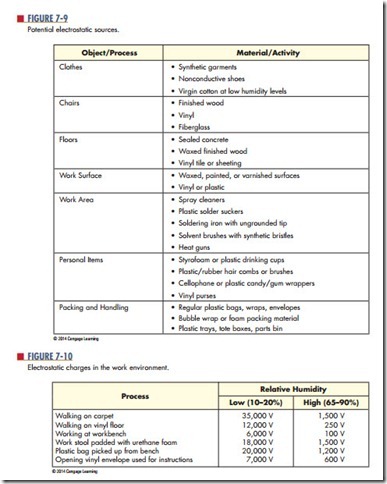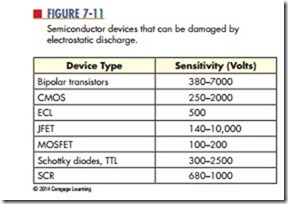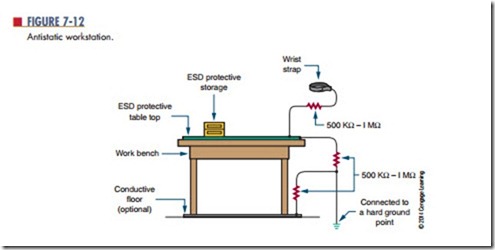electrostatic Discharge
static electricity is created when two substances are rubbed together or separated. The substances can be solid or fluid. The rubbing or separating causes the transfer of electrons from one substance to the other. This results in one substance being positively charged and the other substance being negatively charged. When either substance comes in contact with a conductor, an electrical current flows until it is at the same electrical potential as ground. This is referred to as electrostatic discharge (esD).
Static electricity is commonly experienced during the winter months when the environment is dry. Synthetics, especially plastic, are excellent generators of static electricity. When a person walks across a vinyl or carpeted floor and touches a metal doorknob or other conductor, an electrical arc to ground may result and a slight shock is felt. For a person to feel a shock, the electrostatic potential must be 3500 to 4000 volts. It typically takes 5000 volts to jump one-quarter of an inch. Lesser voltages are not apparent to a person’s nervous system even though they are present.
Inside an integrated circuit, a static discharge can destroy oxide layers or junctions. These static dis- charges can cause an ESD latent defect. The device may appear to operate properly, but it is damaged. It has been weakened, and failure will result at a later time. There is no method for testing for ESD latent defect.
Figure 7-9 displays potential sources for generating an electrostatic discharge. Figure 7-10 shows
typical measured electrostatic charges in a work environment. Figure 7-11 presents a list of electronic parts that may be damaged by sensitivity to electro- static discharge.
antistatic workstations (Figure 7-12) are de- signed to provide a ground path for static charges that could damage a component. They have a conductive or antistatic work surface that is connected to both a ground and the worker’s skin through a wrist strap. The wrist strap has a minimum of 500 kΩ resistances to prevent shock in case of contact with a live circuit. When direct grounding is impractical, an ionized air blower is required.
The following list identifies precautions required to minimize electrostatic discharge:
1. Before starting work on sensitive electronic equip- ment or circuits, the electronics technician should be grounded using a wrist strap to discharge any static electric charge built up on the body.
2. Always check manuals and package materials for ESD warnings and instructions.
3. Always discharge the package of an ESD-sensitive device before removing it. Keep the package grounded until the device is placed in the circuit.
4. Minimize the handling of ESD devices. Handle an ESD device only when ready to place it in the circuit.
5. When handling an ESD device, minimize physical movement such as scuffing feet.
6. When removing and replacing an ESD device, avoid touching the component leads.
7. Do not permit an ESD device to come in contact with clothing or other ungrounded materials that could have an electrostatic discharge.
8. Before touching an ESD device, always touch the surface on which it rests for a minimum of 1 second to provide a discharge path.
9. When working on a circuit containing an ESD device, do not touch any material that will create a static charge.
10. Use a soldering iron with the tip grounded. Do not use plastic solder suckers with ESD devices.
11. Ground the leads of test equipment momentarily before energizing the test equipment and before probing an ESD device.
Questions
1. How is an electrostatic charge generated?
2. What voltage discharge potential can be felt by humans?
3. What is meant by ESD latent defect?
4. An electronics technician who is working on ESD-sensitive devices would prepare by doing what first?
5. Is it safe to remove an ESD device before start- ing to work on a circuit?


